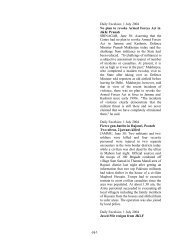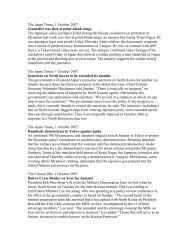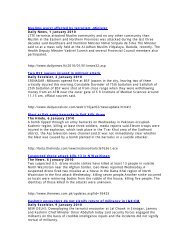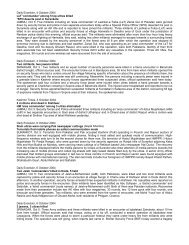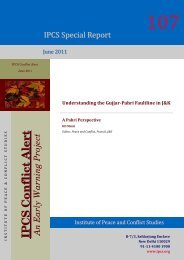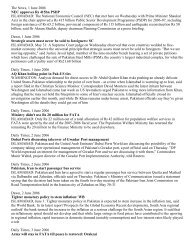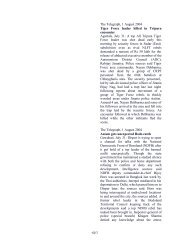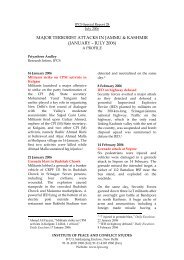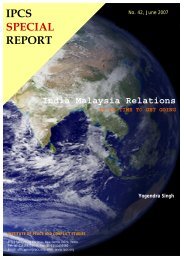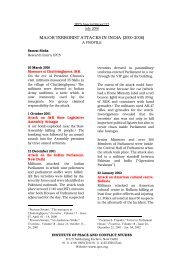April-June 2013 - Institute of Peace and Conflict Studies
April-June 2013 - Institute of Peace and Conflict Studies
April-June 2013 - Institute of Peace and Conflict Studies
Create successful ePaper yourself
Turn your PDF publications into a flip-book with our unique Google optimized e-Paper software.
A close look at the election pattern in Kargil before the formation<br />
<strong>of</strong> the Ladakh Autonomous Hill Development reveals the close<br />
alliance between the political <strong>and</strong> religious elites.<br />
Religious institutions play a dual role during the elections; by<br />
firstly mobilising <strong>and</strong> determining the voting patterns in Kargil,<br />
<strong>and</strong> secondly, in providing legitimacy to the political elites. In the<br />
present context, with the formation <strong>of</strong> the Ladakh Autonomous<br />
Hill Development Kargil, the religious elite have not only limited<br />
themselves to the role <strong>of</strong> 'king makers', but have also begun to<br />
actively participate in the process by contesting the elections<br />
themselves.<br />
Muzaffar Hussain, Ph.D. Scholar at JNU; from Chushot (Leh)<br />
The everyday engagement <strong>of</strong> armed forces in Ladakh, <strong>and</strong> its<br />
interactions with the civilian population, shows the various ways<br />
in which the military has become an important institution in<br />
Ladakhi society.<br />
From the very onset, the military was involved in a range <strong>of</strong><br />
activities, which affected the life <strong>of</strong> people both directly <strong>and</strong><br />
indirectly. It affected the economy by emerging as a key<br />
consumer <strong>of</strong> domestic products. It also created job<br />
opportunities for people, <strong>and</strong> fulfilled civic needs by <strong>of</strong>fering<br />
services related to health, transportation, <strong>and</strong> education.<br />
By fulfilling some <strong>of</strong> the basic requirements <strong>of</strong> the masses, the<br />
military filled the gaping holes in various areas <strong>of</strong> civic<br />
governance. Such involvement <strong>of</strong> the military was<br />
institutionalised in 2002 with the introduction <strong>of</strong> Operation<br />
Sadbhavna in Ladakh, which was earlier launched in certain<br />
areas <strong>of</strong> the military's Northern Comm<strong>and</strong> in 1998.<br />
Zainab Akhter, Research Officer at IPCS, New Delhi, <strong>and</strong> Ph.D.<br />
Scholar at JNU; from Zanskar (Kargil)<br />
Ladakh is <strong>of</strong> great strategic importance to India. There is a huge<br />
problem <strong>of</strong> connectivity; be it the issue <strong>of</strong> connecting the regions<br />
within Ladakh, or connecting it externally to countries with<br />
which it shares its borders.<br />
The people <strong>of</strong> Ladakh face many hardships during the harsh<br />
winter season, wherein the entire region remains inaccessible<br />
for more than six months. The NH1 connecting Srinagar to Kargil,<br />
<strong>and</strong> the Manali-Leh road, are the only connecting links (roads)<br />
between Ladakh <strong>and</strong> other parts <strong>of</strong> India, which remain blocked<br />
for six months owing to heavy snowfall.<br />
Although Leh is connected aerially <strong>and</strong> a private air service called<br />
Air Mantra was launched this year in an effort to connect Kargil<br />
to Jammu, the ground realties still remain the same. There are<br />
other alternative routes which can be explored as they have the<br />
potential to remain open the whole year round.<br />
Resource Person: SS Bloeria, Vice Chancellor, Central University<br />
<strong>of</strong> Jammu<br />
The LAHDC has played a vital role in bringing about development<br />
in the region. Although Kargil accepted the autonomous body a<br />
little later, it has nonetheless proven beneficial for the people.<br />
The army has also contributed to the positive development <strong>of</strong><br />
the region, <strong>and</strong> has been able to open up schools <strong>and</strong> hospitals<br />
in order to bring about affirmative changes. Earlier, the region<br />
was totally inaccessible <strong>and</strong> people used to travel by foot or on<br />
horseback; but now, the situation has improved to a great<br />
extent. Despite this, a lot is yet to be done in order to improve<br />
connectivity in the region during the winter season.<br />
THEME II: Society <strong>and</strong> Culture<br />
Chimat Ladol, M.Phil. Scholar at JNU; from Changthang (Leh)<br />
There exists in Ladakh, a strong social structure which<br />
subordinates women. The social structure is further<br />
strengthened by cultural-religious norms which define, <strong>and</strong><br />
reiterate what women are, <strong>and</strong> how they should behave.<br />
Women have to bear the brunt <strong>of</strong> tradition <strong>and</strong> culture, while<br />
the men-folk not only escape the responsibility <strong>of</strong> preserving the<br />
culture, but also define codes <strong>of</strong> conduct for women.<br />
Ladakhi women still do not consider the personal political, which<br />
then reflects the blanket cover over domestic violence. Women<br />
are disciplined to reiterate their identity not only by maledominated<br />
associations, but also by female-run organisations.<br />
Though the lead by women in field work is seen as a matter <strong>of</strong><br />
pride by those claiming equality for women, one needs to look<br />
into how even after taking care <strong>of</strong> everything - from fields to<br />
households - the work done by women still remains inferior to<br />
men.<br />
There are two types <strong>of</strong> marriages in Ladakh, which Katherine Hay<br />
has talked about, magpa <strong>and</strong> bagma. In the magpa type <strong>of</strong><br />
marriage, the male moves in with the wife's family, <strong>and</strong> is<br />
generally sympathised with by the people in the sense that the<br />
groom has to bear with the bride's family; while the latter<br />
bagma, is seen as acceptable <strong>and</strong> 'natural' no matter how much<br />
the bride suffers.<br />
Sumera Shafi, Ph.D. Scholar at JNU; from Leh<br />
In the pre-independence era, Ladakh boasted <strong>of</strong> a syncretised<br />
society with a composite culture. It was, therefore, common for<br />
people from the two religious communities to inter-marry <strong>and</strong><br />
possess names such as Rigzin Ali, Namgial Musa, etc. There was<br />
an ideal sense <strong>of</strong> communal harmony, which has been eulogised<br />
by some scholars who <strong>of</strong>ten referred to it as the 'last Shangri-La'.<br />
It is true that Ladakh has been insulated from any sort <strong>of</strong> internal<br />
violence <strong>of</strong> the magnitude experienced in its neighbouring area<br />
<strong>of</strong> Kashmir. However, recent historical developments, especially<br />
the induction <strong>of</strong> Ladakh into the national boundaries <strong>of</strong> India in<br />
1947, <strong>and</strong> the influx <strong>of</strong> modernisation into the otherwise cut-<strong>of</strong>f<br />
area, has led to substantial transformations. Since then, not only<br />
has there been an increased religiosity, but also an immense<br />
politicisation <strong>of</strong> religion, with the syncretised Ladakhi identity<br />
thus getting eclipsed by identities based on religious lines.<br />
The politicisation <strong>of</strong> religion in Ladakh has led to communal<br />
violence <strong>and</strong> identity politics, which has been detrimental to<br />
peace in the region.<br />
Fayaz Hussain, Ph.D. Scholar at Punjab University, Ch<strong>and</strong>igarh;<br />
from Kargil<br />
The minority Buddhists claim that there was a monastery in<br />
ruins in Kargil town, near general hospital, which they wanted to<br />
renovate. However, the majority Muslims opposed this claim<br />
after which the place has been declared disputed by the<br />
authorities.<br />
The dem<strong>and</strong> to be declared an union territory, <strong>and</strong> for an<br />
Autonomous Hill Development Council by the political leaders <strong>of</strong><br />
Leh in the early nineties, without consulting the political <strong>and</strong><br />
religious leaders <strong>of</strong> Kargil, created doubt <strong>and</strong> distrust in the<br />
minds <strong>of</strong> people in Kargil.<br />
Recently in 2012, tensions erupted in the Zanskar valley <strong>of</strong> Kargil<br />
South Asia Plus 35



